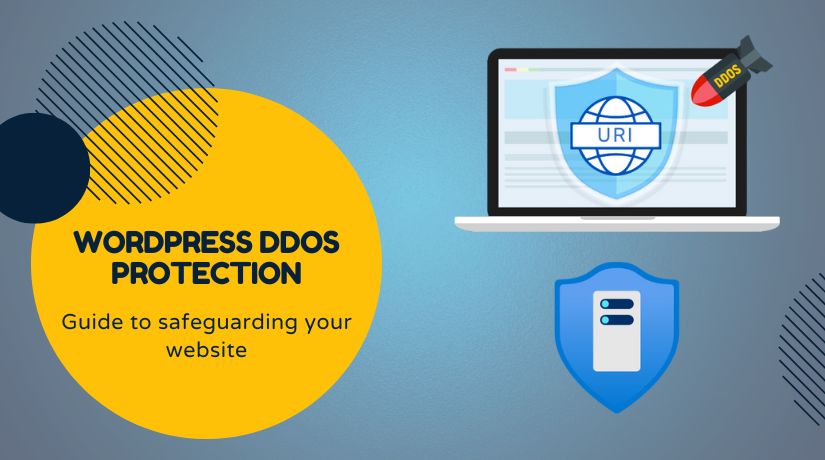
Table of Contents
- Signs Your WordPress Website Is Under a DDoS Attack
- Best Practices for WordPress DDoS Protection
- Effective Tools for WordPress DDoS Protection
- How to Recover From a DDoS Attack
- Conclusion
DDoS attacks are a growing threat to WordPress websites. These attacks flood servers with fake traffic, causing downtime. Website owners face revenue loss, SEO penalties, and poor user experiences. It’s critical to defend your WordPress website from DDoS assaults. Security precautions guarantee that your website remains operational and reachable. This post describes WordPress DDoS Protection procedures and resources.
What Is a DDoS Attack?
The acronym for a DDoS assault is “Distributed Denial of Service.” It entails flooding a server with too much traffic. Bots or hacked devices are frequently the source of the traffic. This makes the website slow, unresponsive, or completely offline. Hackers use DDoS attacks to disrupt businesses or demand ransom. These attacks don’t steal data but can cause financial damage. They also harm your website’s reputation among users and customers.
Why WordPress Websites Are Common Targets
More than 40% of all websites on the internet are powered by WordPress. Because of its popularity, hackers want to target it. Security recommended practices are not followed by many WordPress users. Vulnerabilities may arise from outdated plugins or themes. Attackers use these flaws to initiate DDoS assaults. WordPress websites are also easy candidates for weak login passwords. To have the most impact, hackers try to take down well-known platforms.
Signs Your WordPress Website Is Under a DDoS Attack
Identifying a DDoS attack early is critical to limit its impact.
Website Slows Down or Becomes Unavailable
A sudden slowdown in website speed may indicate unusual activity. If your site is completely offline, check for potential DDoS traffic.
High Server Resource Usage
DDoS attacks cause spikes in CPU and RAM usage. Monitoring tools can show unusual resource activity during attacks.
Unusual Traffic from Suspicious Sources
Look for visitors from unfamiliar locations or devices. A sudden traffic surge from specific regions can signal a DDoS attempt.
Frequent Errors Displayed to Users
Errors like “503 Service Unavailable” or “508 Resource Limit Reached” are common. These indicate the server is overwhelmed and struggling to handle requests.
Best Practices for WordPress DDoS Protection
DDoS assaults are less likely when precautions are taken. The following are recommended procedures for safeguarding your WordPress website:
Choose a Reliable Hosting Provider
Choose a hosting company that offers integrated DDoS Protection. WordPress security is the area of expertise for hosting companies like Kinsta and WP Engine. To manage unexpected spikes in traffic, some suppliers provide scalable resources. Malicious traffic can be filtered by a trustworthy host before it reaches your website.
Use a Content Delivery Network (CDN)
To avoid overload, CDNs divide traffic among several servers. Strong DDoS mitigation features are provided by services like Sucuri and Cloudflare. During an assault, a CDN lessens the strain on your primary server. Additionally, they automatically detect and stop questionable traffic.
Install a Security Plugin
Security plugins strengthen your WordPress defenses against DDoS attacks. Popular options like Wordfence, MalCare, and Sucuri monitor traffic for threats. These plugins can block IPs generating high traffic volumes. Many also include firewalls to prevent unauthorized access.
Limit Login Attempts
Brute force login assaults can be avoided by limiting the number of login attempts. Login Lockdown and Limit Login Attempts Reloaded are useful plugins. After several unsuccessful login attempts, these programs ban IPs. This lessens the possibility that bots may take advantage of weak credentials.
Enable a Web Application Firewall (WAF)
Malicious traffic is tracked and blocked by a WAF before it reaches your website. Sucuri’s Firewall and Cloudflare’s WAF are excellent choices. They let authorised people see your website while blocking malicious queries.
Optimize Website Resources
Caching plugins and optimized databases reduce your server’s workload. WP Rocket and W3 Total Cache improve your site’s speed and stability. A lighter, faster website handles legitimate traffic better during an attack.
Effective Tools for WordPress DDoS Protection
Using the right tools strengthens your WordPress site’s defenses. Here are some of the best tools for protecting against DDoS attacks:
Cloudflare
One of the most widely used DDoS protection systems is Cloudflare. For WordPress websites, it provides a free plan with minimal security measures. With its subscription services, the site offers enhanced protection. The way Cloudflare’s DDoS mitigation operates is by detecting and removing malicious traffic. It distributes traffic across several servers over a worldwide network. Additionally, the tool enhances the functionality and speed of your website. Its dashboard provides comprehensive information and real-time traffic monitoring.
Sucuri
Sucuri is an all-in-one security tool for WordPress websites. It provides excellent DDoS protection and malware scanning features. Sucuri’s Web Application Firewall (WAF) blocks malicious traffic effectively. The firewall inspects every request before it reaches your server. Sucuri also offers CDN services to reduce server load during traffic spikes. It includes detailed logs to help analyze and prevent future attacks. The tool works seamlessly with WordPress through its dedicated plugin.
MalCare
MalCare is a security solution designed specifically for WordPress that has DDoS protection capabilities. It keeps an eye on traffic in real time to spot any unusual trends. IPs causing unusual traffic volumes are immediately blocked by MalCare. Brute force prevention, virus detection, and firewall security are some of its characteristics. The platform takes little configuration and is simple to set up. During an assault, MalCare’s cloud-based solution lessens the strain on your server. Additionally, it offers thorough reports to raise the general security of your website.
Wordfence
A well-liked WordPress plugin for complete website security is called Wordfence. It has DDoS protection capabilities including traffic monitoring and IP filtering. Malicious traffic is blocked by Wordfence’s firewall before it even gets to your website. Its login security feature restricts attempts and prevents unauthorised logins. A free version of the program with less security features is available. The premium edition offers more sophisticated features including country blocking. Wordfence operates straight from your WordPress dashboard and is simple to install.
Akamai
Akamai provides enterprise-grade DDoS protection for high-traffic WordPress websites. It specializes in handling large-scale DDoS attacks with its cloud-based system. Akamai’s platform automatically detects and mitigates unusual traffic patterns. Its services are ideal for businesses with a global audience and heavy traffic. Akamai also offers advanced analytics for understanding traffic trends. This tool is best suited for large organizations or eCommerce websites.
How to Recover From a DDoS Attack
Take immediate action if a DDoS attack occurs on your WordPress website. To recover your website and get it functioning normally again, follow these steps:
Identify the Source of the Attack
Use your hosting dashboard or security plugins to check traffic logs. Look for unusual traffic sources or patterns that may indicate the attack origin. Identifying the IPs involved can help block malicious requests.
Block Malicious IPs and Traffic
Block malicious IPs with your firewall or security plugin. Quick IP blocking is possible with several solutions, such as Wordfence or Cloudflare. This restores website access and lessens the load on your server.
Contact Your Hosting Provider
Inform your hosting provider about the DDoS attack immediately. Many hosting providers offer support during such incidents. They can add extra resources or apply server-level blocks to mitigate the attack.
Enable Emergency Security Measures
Activate maintenance mode to protect your website temporarily. Use plugins like WP Maintenance Mode to notify users about ongoing fixes. This prevents attackers from overwhelming your site further.
Analyze Logs and Improve Security
Examine your traffic records to learn how the assault occurred. Find any weaknesses in your configuration, such out-of-date plugins or insecure passwords. Boost your defences with these insights.
Update WordPress and Plugins
Make sure all of your WordPress themes, plugins, and core are up to date. Security fixes that address known vulnerabilities are frequently included in updates. Updating your website lowers the possibility of more assaults.
Conclusion
DDoS attacks can severely harm WordPress websites if left unchecked. Proactive protection is essential to keep your site secure and functional. Use best practices and reliable tools to minimize the risk of attacks. If an attack occurs, act quickly to recover and analyze weaknesses. Putting money into security guarantees that your website will always be reliable and accessible. To defend your WordPress website from DDoS attacks, begin putting these precautions into practice right now.

